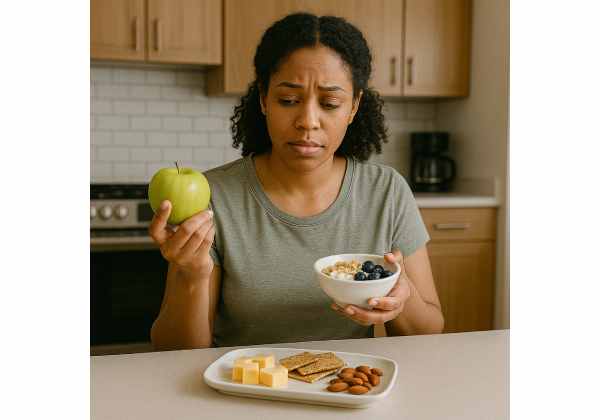
Cravings are not character flaws; they are biology plus routine. When hunger peaks or stress spikes, your brain looks for fast energy. The smartest response is not to white-knuckle it. It is to keep compact, high-protein foods within reach and pair them with fast fiber so fullness arrives quickly—and lasts. In this guide, you will learn how to build a ready-to-use toolkit for afternoon slumps, late-night nibbling, and travel days. You will also get five-minute recipes, packable options, and a 30-day plan to make these choices automatic. If you are also improving sleep, stress, and daily habits, start with our foundation on habit, sleep, and stress skills and plug the snack playbook below into that routine.
Table of Contents
- Do quick protein snacks work?
- How to build your craving toolkit
- Protein snack ideas that take 2–5 minutes
- Fiber fixes that actually satisfy
- Common mistakes and easy fixes
- Who should adjust or avoid
- What to expect in 30 days
- Frequently Asked Questions
Do quick protein snacks work?
Short answer: yes—when you use them strategically. Cravings tend to hit when blood sugar drops, meals are delayed, or you are stressed and under-slept. Protein helps because it raises satiety signals, slows gastric emptying, and steadies energy. Add fiber and water, and you get a stronger “off switch” without a calorie spike. The goal is not a perfect macro split; it is fast relief that prevents a spiral.
Here is how a craving toolkit supports weight loss:
- Pre-emption: A planned protein snack in the longest gap (for many, 3–5 p.m.) prevents the frantic search for sweets on the commute home.
- Substitution: A high-protein, high-fiber choice replaces a habit food (vending-machine candy, pastry with coffee) while still feeling satisfying.
- Delay: Ten minutes after a quick protein + fiber hit, urges usually soften. That pause lets you make the next decision on purpose.
What “works” means in real life:
- Protein target per snack: about 15–25 g for most adults.
- Fiber add-on: 4–8 g via fruit, veg, legumes, chia, flax, or whole grains.
- Speed: 2–5 minutes from thought to first bite, no full kitchen required.
- Portability: Sealed items for the car, desk, or bag so you are not at the mercy of whatever is nearby.
Where this fails is when snacks are too small, too sugary, or too late (after hunger is already high). If you routinely “graze” at night, a structured afternoon protein anchor plus a fiber-forward dinner cuts evening drive because you are not arriving depleted.
Protein and fiber do not do the work alone; consistency does. Pair this toolkit with clear guardrails—simple plates, steps, and bedtime routines—and cravings shrink in frequency and intensity over weeks, not days. If you want safe pacing and plate structure that complements this toolkit, skim our concise notes on weight-loss basics.
A quick experiment for this week
- Put two protein items in your desk or bag. 2) Put two fiber “add-ons” in the same place. 3) Use them once daily in your longest food gap. 4) Rate your hunger and cravings before and 20 minutes after. Adjust portions, not willpower.
How to build your craving toolkit
Think of your toolkit as three boxes you can grab from anywhere: desk, fridge, and travel. Stock each with one-handed foods that do not require cooking and deliver protein plus fiber quickly. Then create a 2-step rule you follow when an urge hits: protein first, fiber second. The order matters because protein quiets hunger fast; fiber sustains it.
Box 1: Desk / glove compartment (shelf-stable)
- Foil tuna or salmon pouches (80–100 g): 16–20 g protein.
- Roasted edamame or broad beans (30 g): 12–15 g protein, 5–8 g fiber.
- Jerky or biltong (30 g): 12–18 g protein (choose lower-sugar options).
- Protein bar with simple ingredients (look for 15–20 g protein, <8 g fiber to avoid GI issues).
- Instant protein oatmeal cup (add hot water): 10–15 g protein, 4–7 g fiber.
Box 2: Fridge (home or office)
- Greek or skyr yogurt (170–200 g): 15–20 g protein; add berries (4–6 g fiber).
- Cottage cheese (200 g): 22–26 g protein; add cherry tomatoes or sliced cucumber.
- Boiled eggs (2): 12–14 g protein; add a small apple (3–4 g fiber).
- Deli turkey or chicken roll-ups (100 g): 18–24 g protein; add carrot sticks.
- Tofu cubes (150 g) with soy sauce and sesame seeds: 15–18 g protein; pair with edamame.
Box 3: Travel (airports, hotels, late meetings)
- Single-serve shelf-stable shakes (look for 20–30 g protein).
- Nut butter squeeze pack (7–9 g protein); pair with an apple or banana.
- Microwave-in-bag lentils or chickpeas (½ cup): 7–9 g protein, 6–8 g fiber.
- Instant miso soup cup; add edamame or a tuna pouch.
The 2-step rule in practice
- Protein first (yogurt, tuna, tofu, protein bar).
- Fiber second (fruit, veg sticks, roasted beans, chia).
If you still want the original food after 10–15 minutes, have a small portion on purpose. Often the urge passes.
Timing that works
- Early afternoon (2–4 p.m.): Plan your strongest protein snack here.
- Post-dinner: If dessert is a habit, go fiber first (e.g., berries + yogurt or chia pudding).
- After meals: A 10-minute walk reduces post-meal cravings by shifting focus and smoothing blood sugar. For a simple walk routine, see the quick start in after-meal walks.
Label your kit
Write a sticky note with: “Protein first, fiber second, 10-minute pause.” Small prompts replace decision fatigue when you are stressed.
Protein snack ideas that take 2–5 minutes
You do not need a kitchen to eat well. Use these plug-and-play ideas for workdays, school runs, and late nights. The guiding principle: 15–25 g protein with a quick fiber add-on.
Grab-and-go pairs
- Greek yogurt cup + ½ cup berries: ~18 g protein, 4–6 g fiber.
- Cottage cheese + diced tomato and cucumber: ~22 g protein, 2–3 g fiber.
- Tuna pouch + whole-grain crackers (4–6): ~18–20 g protein, 3–4 g fiber.
- Jerky (30 g) + medium apple: ~15 g protein, 4–5 g fiber.
- Roasted edamame (30 g) + clementine: ~14 g protein, 6 g fiber total.
Microwave-optional
- Egg mug: Whisk 2 eggs + splash of milk in a mug, microwave 60–90 seconds; add salsa. ~12–14 g protein. Pair with a small pear for fiber.
- Microwave lentils (½ cup) + feta (30 g): ~13–15 g protein, 8 g fiber.
Plant-forward options
- Tofu cubes (150 g) + edamame (½ cup): ~25–28 g protein, 6–8 g fiber.
- Hummus (¼ cup) + veg sticks + roasted chickpeas (¼ cup): ~10–12 g protein, 6–8 g fiber.
Sweet-leaning but steady
- High-protein skyr + sliced banana + cinnamon: ~17–20 g protein, 3–4 g fiber.
- Chia yogurt (½ cup yogurt + 1 Tbsp chia, 10 min): ~17–20 g protein, 5 g fiber.
On the road
- Shelf-stable protein shake + popcorn (3 cups): ~20–30 g protein, 3–4 g fiber.
- Nut butter pack + apple: ~7–9 g protein, 4–5 g fiber (add a cheese stick to reach 15–20 g protein).
If you prefer bars
Choose bars with 15–20 g protein, ≤10 g added sugar, and ≤8 g fiber (excessive added fiber can cause GI upset). Pair with fruit or veg to get “real” fiber and water.
Sizing your snack
- If your next meal is >3 hours away, aim for ~250–300 kcal and the full 15–25 g protein.
- If your next meal is <2 hours away, use ~100–150 kcal and 10–15 g protein (e.g., skyr mini, egg + veg).
When late-night cravings hit
- Go protein + fiber: skyr + berries, cottage cheese + peaches, tofu + edamame.
- If you still want something sweet, add a small square of dark chocolate after the protein. Many find the craving is satisfied with far less.
For a deeper routine that defends evenings—screens, light, and wind-down—see the practical night strategies in ending late-night snacking.
Fiber fixes that actually satisfy
Fiber is the quiet hero of your craving toolkit. It adds volume, slows digestion, and signals fullness. The trick is choosing fast, tasty fiber you will actually use—not just salad on good days.
Fruit first
- Berries (1 cup): 4–8 g fiber, low energy density, great with yogurt.
- Pears or apples (medium): 4–6 g fiber, portable, pair well with cheese or jerky.
- Kiwi (2): ~4 g fiber, tangy; helps when you want “fresh and sweet.”
Veg that crunches
- Carrots, cucumbers, sugar snap peas, bell pepper strips: easy dippers with cottage cheese or hummus.
- Cherry tomatoes with salt and a drizzle of balsamic alongside deli turkey.
Legume shortcuts
- Roasted chickpeas or broad beans: 5–8 g fiber per 30 g; shelf-stable and crunchy.
- Microwavable lentil pouches: 8–10 g fiber per cup; mix with feta or tuna.
Smart add-ins
- Chia seeds (1 Tbsp): ~5 g fiber; stir into yogurt and wait 10 minutes.
- Ground flaxseed (1 Tbsp): ~2–3 g fiber; sprinkle over cottage cheese or oats.
- Psyllium (½–1 tsp): adds bulk; mix into yogurt or a shake if you tolerate it.
Grain options
- Air-popped popcorn (3 cups): ~3–4 g fiber, large volume for few calories.
- Whole-grain crispbreads (2): 3–5 g fiber; top with tuna or cottage cheese.
“Fiber first” cue
When a craving hits, ask: What is my fastest fiber? Eat it with protein, then pause 10 minutes. A sliced apple with jerky or berries with yogurt changes how the next 200 calories feel—and how long they last.
Hydration and timing
Fiber needs water to work well. Keep a glass nearby and sip during the snack. If high-fiber foods cause bloating, scale up gradually and vary sources (fruit, veg, legumes) instead of maxing out one ingredient.
Fiber is not punishment; it is pleasant fullness. Choose textures and flavors you like so these foods become your default, not your fallback.
For appetite steadiness built into meals, see plate-building ideas in tracking without counting.
Common mistakes and easy fixes
Mistake: Waiting until you are starving
You end up inhaling sweets and calling it a write-off.
- Fix: Schedule a protein anchor in your longest gap. Put the food where the hunger happens (desk, car, bag).
Mistake: “Healthy” snacks that are just sugar
Granola clusters, fruit-only pouches, and yogurt with syrupy toppings spike and crash.
- Fix: Aim for 15–25 g protein and 4–8 g fiber. Add fruit to unsweetened yogurt; choose roasted legumes over candy.
Mistake: Protein without fiber
You are hungry again in an hour.
- Fix: Add berries, veg sticks, or roasted chickpeas. Keep chia or flax at work for a quick stir-in.
Mistake: Oversized “snacks”
A venti dessert coffee plus pastry equals a meal’s calories without the satiety.
- Fix: Keep snack energy proportionate to the gap before your next meal. Use smaller cups and simple coffee.
Mistake: Trigger foods in reach
Open bowls of candy or cookies on the counter turn every pass into a decision.
- Fix: Use opaque containers and move treats out of sight. Place protein and fruit at eye level. For a full kitchen tune-up, see a practical food environment reset.
Mistake: All-or-nothing rules
“Never eat sweets” breaks on real days.
- Fix: Use the 10-minute rule: protein + fiber first, then a small planned portion of the original food if you still want it.
Mistake: Nighttime binges after perfect days
Under-eating + long gaps + stress = rebound.
- Fix: Ensure two protein-rich meals and a planned afternoon snack. Protect sleep and dim evening light, which lowers late cravings.
Slip-ups are information, not identity. Note the trigger (time, place, feeling), adjust environment and timing, and move on. For a short reset protocol, see lapses vs. relapses.
Who should adjust or avoid
Most people benefit from protein-plus-fiber snacks, but some situations need tailored choices.
- Irritable bowel or sensitive gut: Large doses of added fibers (inulin, chicory root, very high-fiber bars) can cause gas and cramping. Start with fruit and cooked veg, then add chia or oats gradually.
- Chronic kidney disease: High protein is not automatically better. Work with your clinician on protein amounts and sources.
- GERD or reflux: Citrus, peppermint, onion, and very fatty snacks can worsen symptoms. Choose low-acid yogurt, cottage cheese, or tofu with gentle fiber like bananas or oats.
- Diabetes or prediabetes: Pair protein + fiber and monitor post-snack glucose responses; avoid sugary coffee drinks and candy “snacks.”
- Food allergies or intolerances: Build parallel kits (e.g., dairy-free yogurt or soy skyr, egg-free options).
- History of disordered eating: Avoid rigid rules and calorie counting. Track behaviors (did I have protein and fiber?) and feelings (am I satisfied?). Seek professional support if cravings and guilt feel overwhelming.
- Kids and teens: Keep language neutral (“foods that help us feel full”). Offer protein + fruit or veg after school; avoid labeling treats as “bad.”
If a snack routinely causes discomfort or urges to overeat, change the food, not your character. The right choice is the one you will use on a hectic Wednesday, not the one that looks ideal on paper.
For nights when cravings are tied to fatigue, a strong sleep routine often helps more than an extra snack. Review practical sleep targets and wind-down basics in how much sleep supports weight loss.
What to expect in 30 days
Week 1: Stock and test
Fill your three boxes (desk, fridge, travel). Use one planned protein + fiber snack in your longest gap daily. Track hunger and cravings before and 20 minutes after the snack on a 1–10 scale. Adjust portions to land in the comfortable middle (3–5).
Week 2: Automate and place
Move snacks to the place of decision (bag, car, desk). Put trigger foods out of sight. Pair afternoon protein with a 10-minute walk or water. Late-night cravings often drop when the afternoon is solid.
Week 3: Personalize
Notice which options you actually like. Keep three favorites and retire the rest. If dairy feels best at night and legumes at work, lean into that. Add one plant-based option if you are heavy on animal protein, or vice versa.
Week 4: Integrate with meals
Shift one meal per day to a protein + high-fiber plate (e.g., eggs + veg + fruit, lentils + veg + tofu). Many people find cravings shrink further when meals and snacks both carry the theme.
Metrics that matter
- Fewer urgent cravings (intensity and frequency).
- Evening snacking reduced or portioned by choice.
- Energy steadier between meals.
- Adherence to your movement and bedtime plans improves.
Expect quiet wins, not fireworks: easier afternoons, more predictable evenings, and fewer “what happened?” nights. Those small, repeatable wins protect your weekly deficit and your sanity.
Frequently Asked Questions
How much protein should a snack have?
Aim for 15–25 g of protein, plus 4–8 g of fiber from fruit, veg, legumes, or whole grains. That range balances fast hunger relief with staying power. If your next meal is soon, use a smaller snack (10–15 g protein) to avoid blunting appetite.
What is the fastest protein snack when I am busy?
Tuna or salmon pouches, skyr or Greek yogurt cups, roasted edamame, and shelf-stable protein shakes are reliable. Pair any of them with fruit or veg sticks for fiber. Keep two options in your bag or desk so you are never forced into candy.
Do protein bars help with cravings?
They can, if you pick well. Choose 15–20 g protein, ≤10 g added sugar, and ≤8 g fiber to avoid GI issues. Pair the bar with fruit or veg to add natural fiber and water, which improves fullness and reduces rebound snacking.
What should I eat when I crave sweets at night?
Go protein + fiber first: yogurt with berries, cottage cheese with peaches, chia yogurt, or tofu with edamame. Wait 10–15 minutes. If you still want something sweet, add a small planned portion. Many find the urge fades after the protein base.
Are fiber supplements as good as food?
They can help, but start with food sources—fruit, veg, legumes, oats—because they deliver fiber with water, micronutrients, and texture. If you add psyllium or inulin, begin with small amounts and extra water to avoid bloating.
Will snacks make me gain weight?
Not if they prevent overeating later. A planned protein-plus-fiber snack in your longest gap often lowers daily calories by reducing impulsive choices. Size the snack to the gap: bigger when meals are far apart, smaller when a meal is close.
References
- Effect of short- and long-term protein consumption on appetite and appetite-regulating gastrointestinal hormones, a systematic review and meta-analysis of randomized controlled trials 2020 (Systematic Review & Meta-analysis)
- Cereal Fibers and Satiety: A Systematic Review 2025 (Systematic Review)
- Gastrointestinal Effects and Tolerance of Nondigestible Carbohydrate Consumption 2022 (Systematic Review)
- 5. Facilitating Positive Health Behaviors and Well-being to Improve Health Outcomes: Standards of Care in Diabetes-2025 2025 (Guideline)
- KDOQI Clinical Practice Guideline for Nutrition in CKD: 2020 Update 2020 (Guideline)
Disclaimer
This guide is educational and not a substitute for personalized medical or nutrition advice. If you have chronic conditions (e.g., kidney disease, diabetes, GERD), food allergies, significant GI symptoms, or a history of disordered eating, consult a qualified clinician or dietitian before changing your routine.
Share and Follow
If this toolkit helped, consider sharing it with a friend who battles afternoon slumps or late-night nibbling. For steady, practical ideas you can use right away, follow us on Facebook, X, or whichever social platform you prefer.










